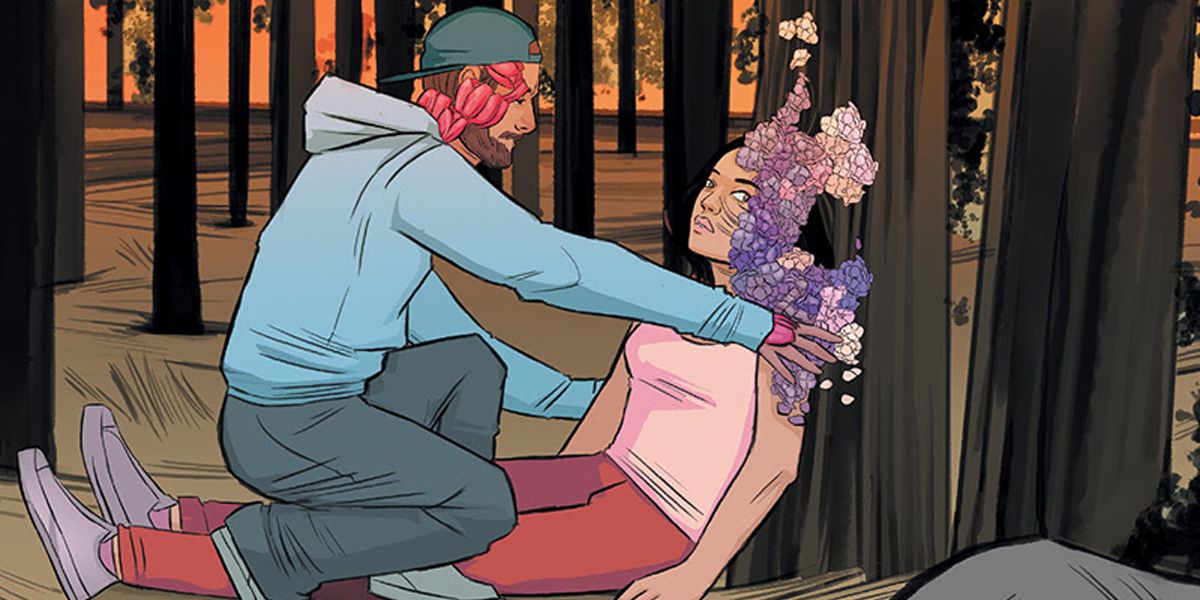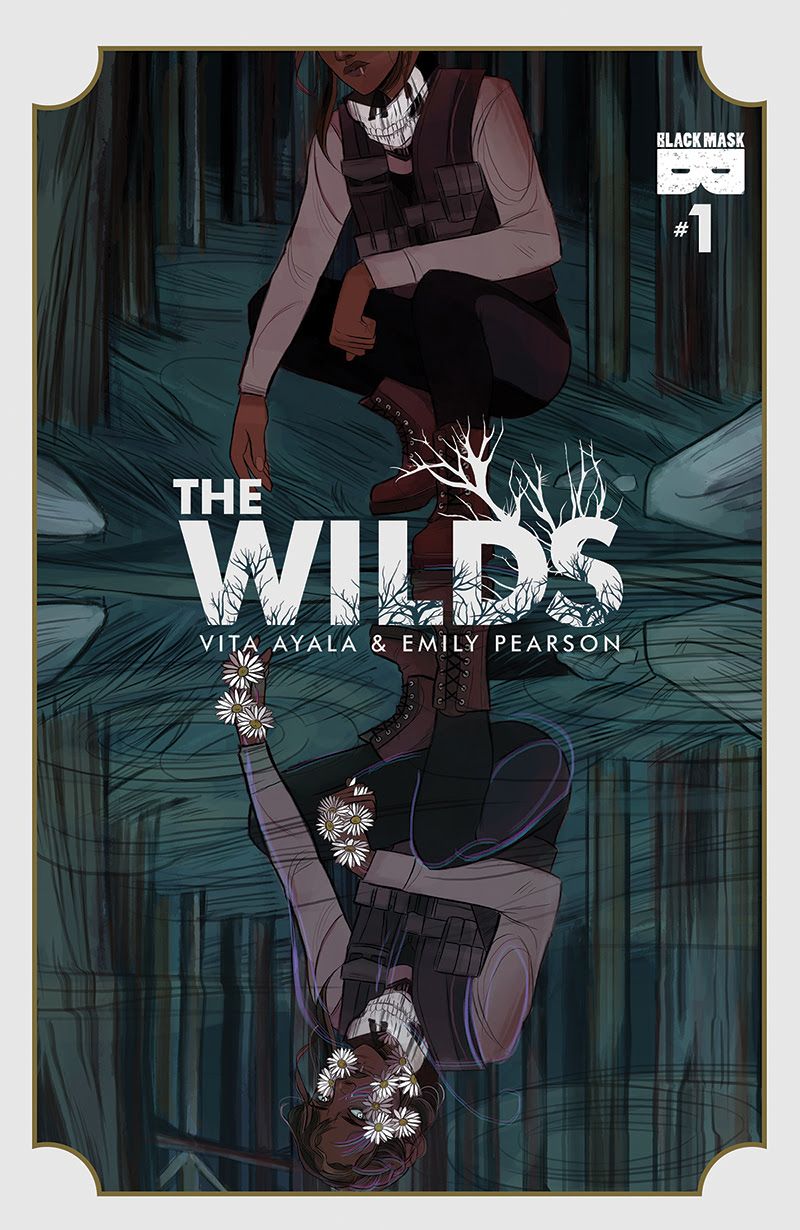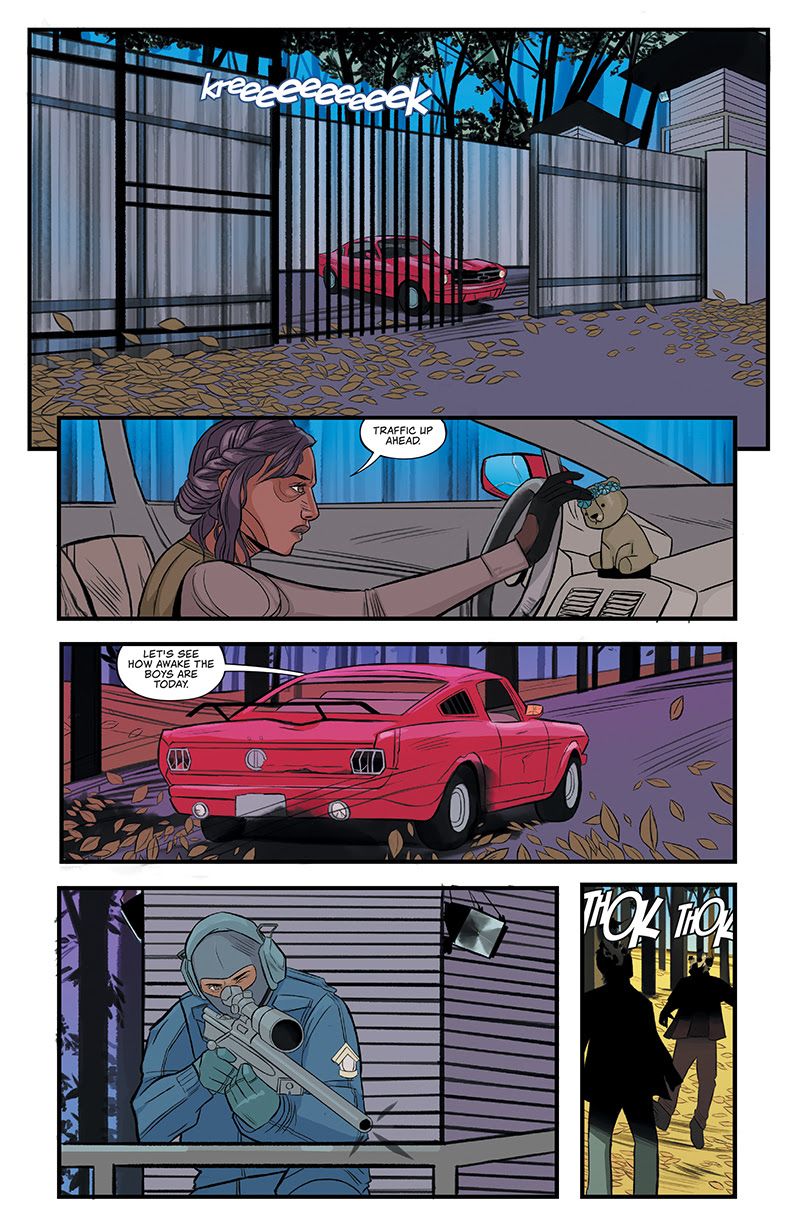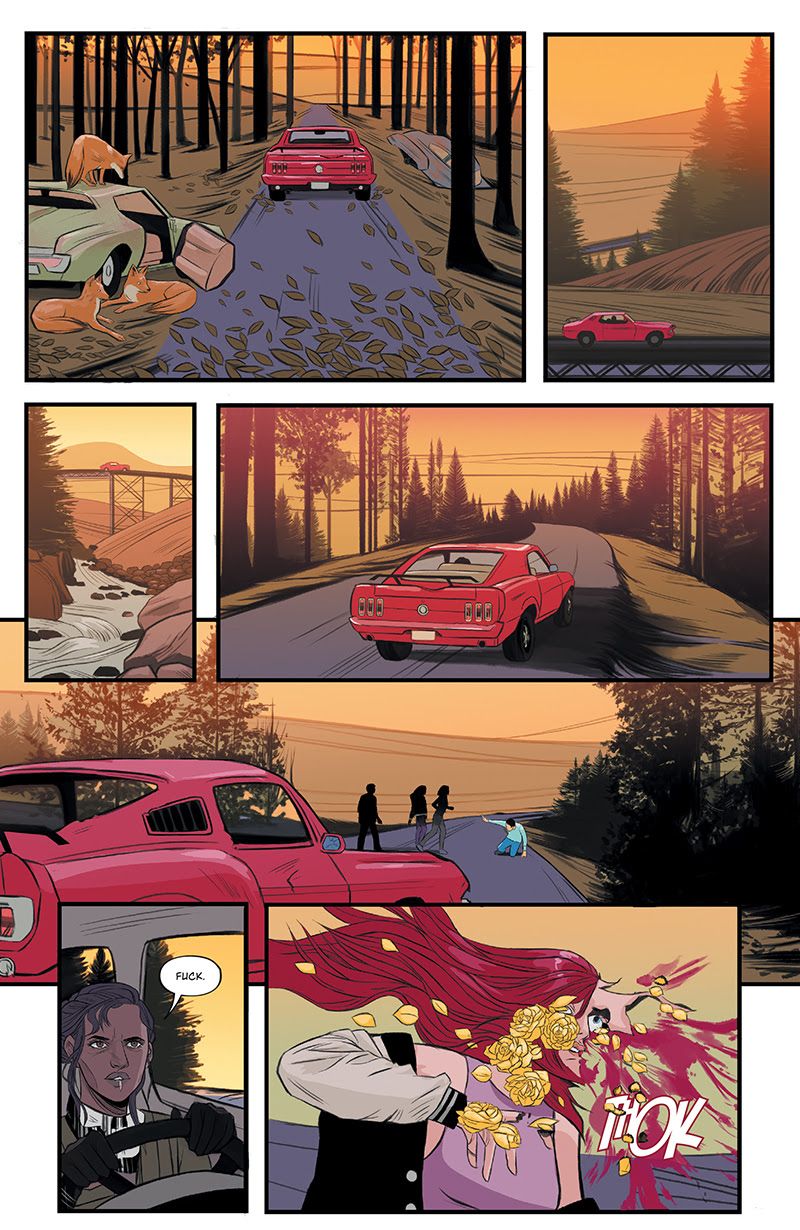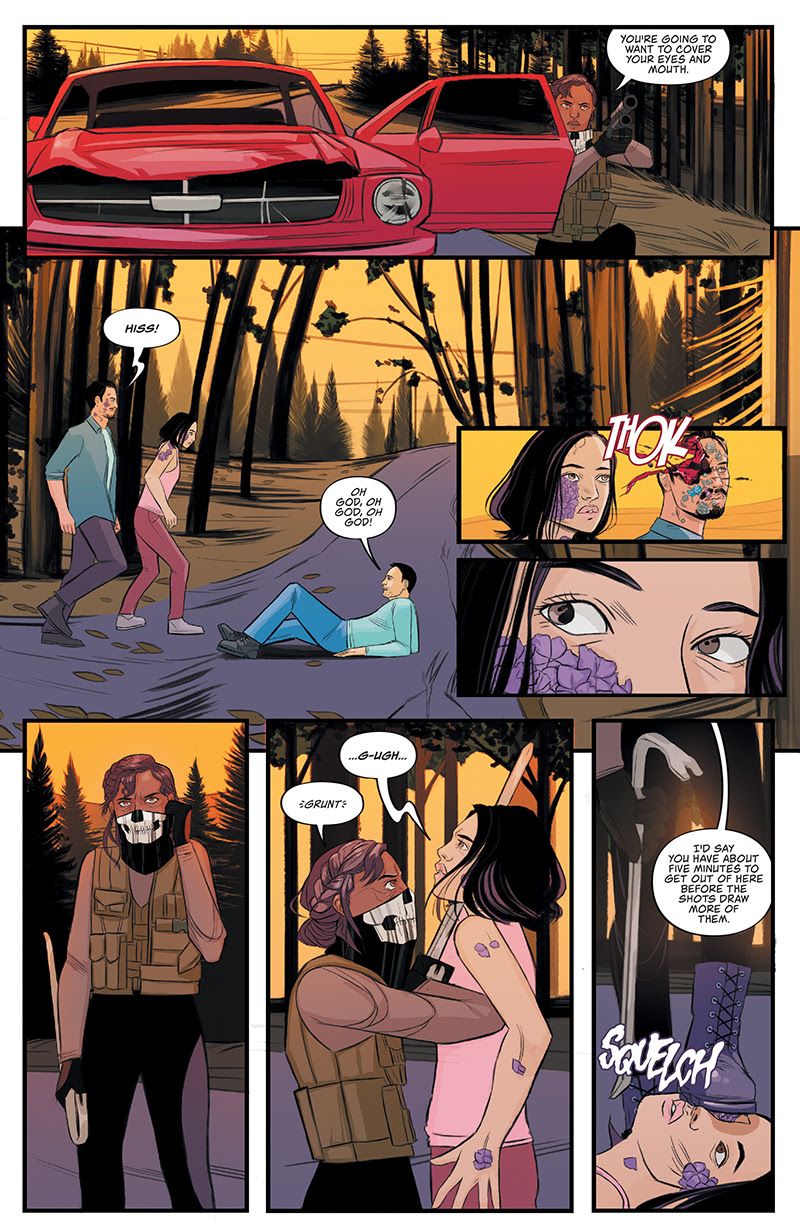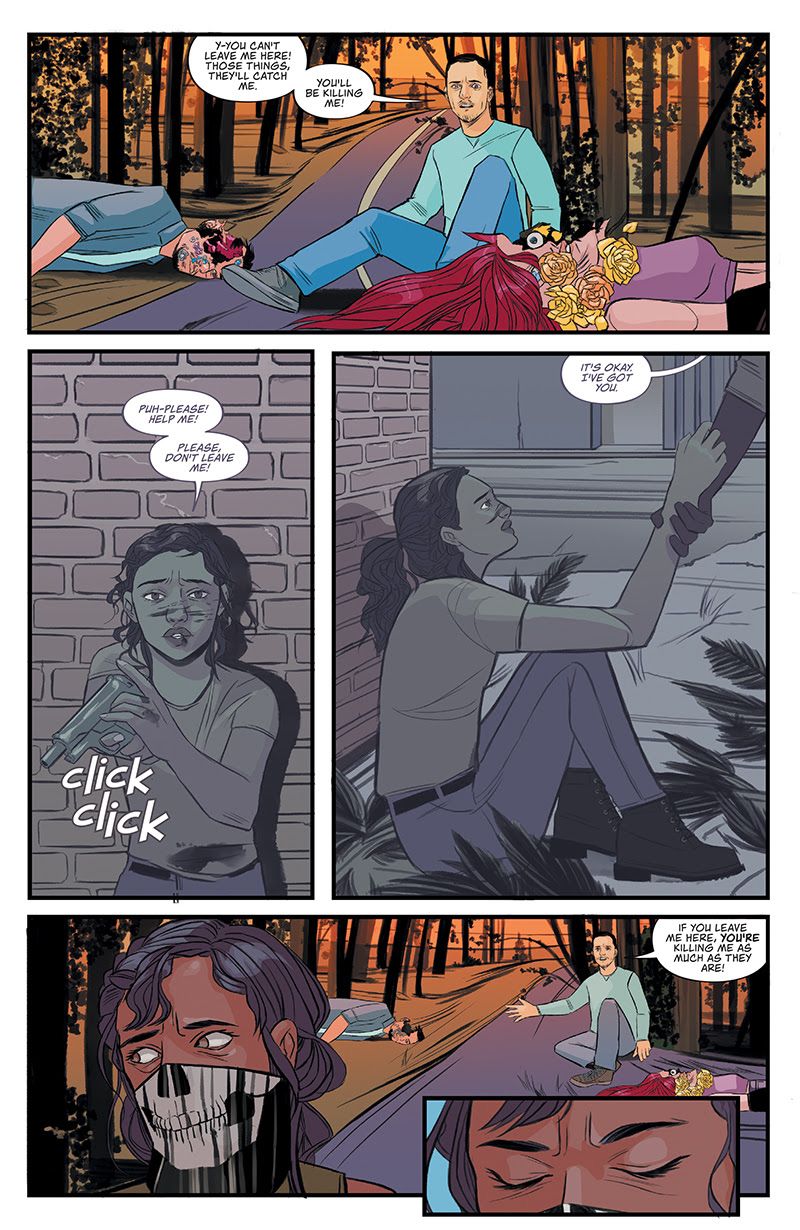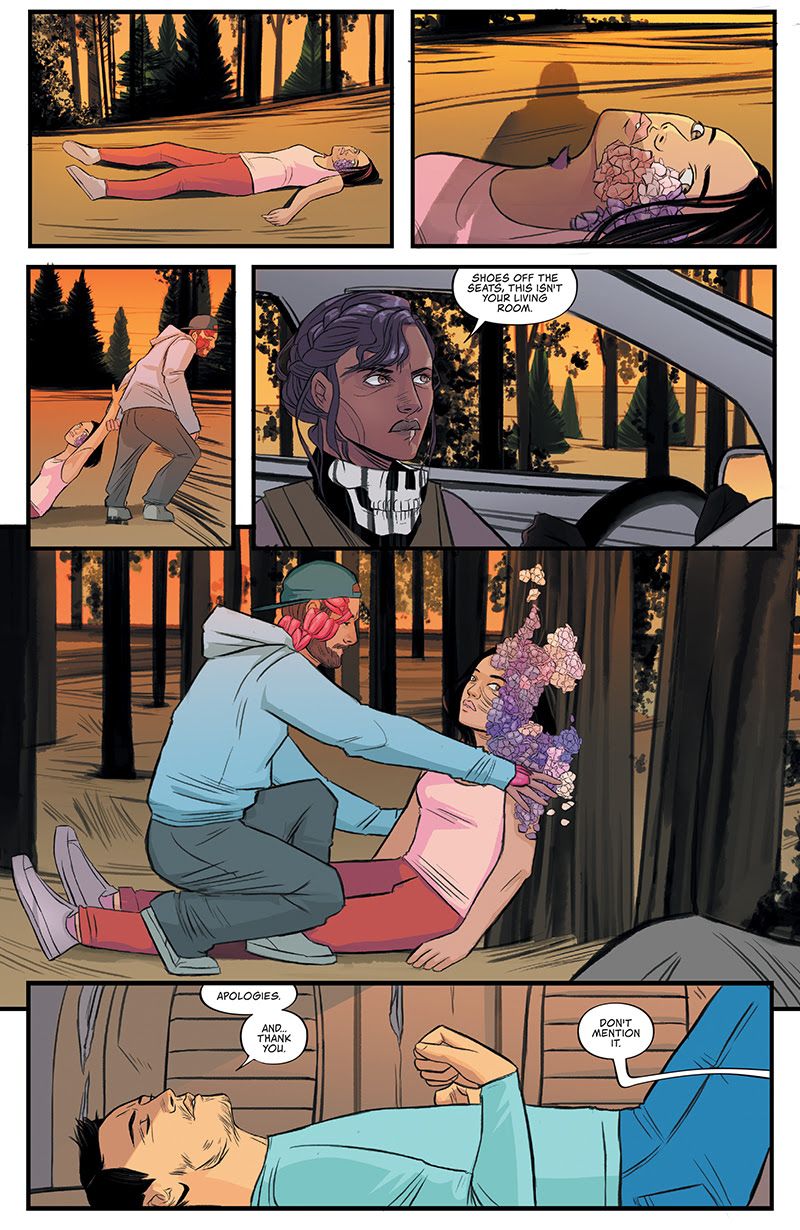The Wilds, the new zombie apocalypse comic from Black Mask Studios, has a very big twist: instead of decaying shamblers, or fast-moving infected, the zombies in The Wilds have become host to flowers. How these Abominations, as they're called in the comic, actually work isn't explained in the first issue. Instead we learn about the chaotic early days of the new plague and the new world that's grown in its wreckage. The flower zombie Abominations have taken over the countryside, with humanity having retreated into armed compounds and walled towns. Only Runners travel safely between communities, delivering supplies, messages, and occasionally people.
The Abominations are so good a concept and their world so quickly and thoroughly established in The Wilds #1 that you'll be willing to wait for that explanation while you get to know runner Daisy, her girlfriend Heather and the rest of the cast in this most unusual zombie apocalypse story.
RELATED: Calexit’s Dystopia Rooted in Real-Life ‘Toxic Political Environment’
CBR caught up with the full Wilds crew -- writer Vita Ayala, penciler Emily Pearson, colorist Marissa Louise, letterer Jim Campbell, cover artist Natasha Alterici, and editor Danny Lore -- to talk flower zombies, apocalypse fiction, and how they put this book together.
CBR: How did you get involved with The Wilds and why did you decide to work on this book?
Emily Pearson: Vita and I were looking for a story to do together, and we went over a few ideas that might be fun to do. The Wilds really stood out to me the most, and we starting working on the book and developing it from there. There’s a lot about The Wilds that’s appealing to me. I love drawing women, nature, cars, and I love apocalypse settings. I’m not too picky when I’m looking to work on a comic -- as long as the story’s good, I’m hooked, and Vita’s the person you call if you want a good story.
Marissa Louise: I don’t remember how I got involved. All I remember was hearing the team and saying yes, then hearing the concept and screaming yes.
Vita Ayala: I have been working on a version of this story (which has gone through two name changes) for years now. It was a story that I initially developed in college with a very good friend, and while it is very different from that seed of an idea, many things have spiritually carried over. When Emily and I started talking about working together, she reinvigorated my enthusiasm for the story. When we worked out the specifics of the Abominations -- the flower zombies -- I knew there was no turning back, I was obsessed.
Danny Lore: Vita and I have always bounced ideas back and forth, and I think I’d seen one of the older iterations of this story. Vita has always come up with the kinds of stories I want to see in the world, so I jumped at the chance to participate. The fact that it was a floral apocalypse just cemented my excitement.
Natasha Alterici: I had made it a goal of mine to do more cover work this year, and to collaborate and support the projects of less white/cis/het/male teams. So it was perfect timing that Vita reached out to me about doing variants for the series. And when I read over all the materials and saw the amazing art that was done for it already, I knew I wanted to be a part of this smart and beautiful series. Plus, how could I say no to painting flower zombies?
I think “flower zombies” is a concept that sells itself, no elevator pitch necessary. But can you tell me a bit about the genesis of the idea, and how the concept developed and changed throughout the process of putting this book together?
Pearson: Neither of us can remember for the life of us which one of us came up with the idea of flower zombies. Vita asked if there’s anything I’d be interested in drawing. I mentioned it might be fun to draw mutated people, but I really didn’t think much of it. Vita ended up changing a lot of the story to include mutations. We ended up talking about it for a while, I went through a couple renditions of what the abominations could look like, and eventually we both settled on the current design of these creepy colorful flower zombies.
Ayala: It was a sort of chemical reaction between Emily and I. I wanted to know what kind of things she was interested in creating and drawing -- I didn’t want her to be miserable for however many months it would be we worked on this. She mentioned she loved drawing nature and cute girls, and that worked well because even in the beginning, nature played a huge role (the secret main character of the book). Figuring out the Abominations was a bit like a jazz jam session. We were in the creative zone, just throwing ideas around, and we ended up making some sweet music!
Pundits keep declaring zombies and post-apocalyptic narratives dead, but The Walking Dead shows no signs of slowing down, and new takes on zombies and extreme survival stories keep coming. Why are zombies and social collapse stories so popular right now, in this historical moment?
Ayala: I think Monsters with capital "M" are cyclical. They represent very real anxieties and fears that we have, and depending on what is happening in our world at any given moment, these fears can surge to the forefront of our consciousness. I think zombies and that sort of horde-like end of the world scenario speak to very real feelings of not just helplessness and anxiety over global catastrophe, but also to feelings of losing the sense of self. They are a sweet spot of very real concerns about the end of civilization [particularly] our specific way of life as it in the present, and corruption.
This genre of story also speaks to people’s need to believe they will survive, against all odds. Sure there may be a literal wave of death coming for me (zombies, plague, nuclear war), but I can make it -- I am strong enough, smart enough, and wily enough to beat the odds.
Zombies are often metaphors for real viral plagues and government failures with respect to public health. Other times they’re about failures in human character: representative of sin or selfishness. And in very bad zombie stories, they’re just an excuse for our heroes to enact violence on mindless bodies. What are the zombies in The Wilds about -- and why flowers?
Ayala: To me, the zombies in The Wilds represent a few things. They represent our fears, about the world and about things we cannot control, about what we really are. They also represent the dangers that people -- especially marginalized people -- face every day, just for existing. Literally walking down the street as a PoC, as a Queer person, as a woman (and all the gods help you if you are all three) is a huge risk, can and does often entail protecting yourself against psychological, emotional or physical violence regularly. The Abominations [or flower zombies] also sort of represent the relentless march of Mother Nature and how it doesn’t care about humanity or our agendas.
Ultimately, while we are a very destructive species, we all end up the same as any other in the end, and when we are gone, nature will cover up our bones and the ruins of our buildings right quick. So I guess, they represent both our internal fears of being powerless and consumed, how we enact violence on people who are socially vulnerable, and also how nature scoffs at our pettiness.
Page 2: [valnet-url-page page=2 paginated=0 text='Normalization over diversity, the long-term plan for The Wilds']
Something that immediately struck me about The Wilds is that the characters we meet are diverse -- obviously. But it stands out because zombie, post-apocalyptic, and survival stories often center white, cis, straight, Western people, with marginalized folks sidelined, dead and dying, or not even present in the background. How did this aspect of the post-apocalyptic genre affect the development of The Wilds, if at all?
Louise: Diversity can really be a buzzword right now. Which is particularly frustrating since there is a lot of course correction that needs to happen with regard to representation in media. This is especially clear with horror; no one is exempt for the existential horror, but some people have more opportunity to express that horror than others.
Ayala: I am not really a fan of the word diversity, for many reasons. I prefer the words normalization -- because let’s be real, most of this planet is not white, and less of it than we are lead to believe are men -- and inclusion.
There were three reasons why this book focuses on the people it does.
One, because I lost count of the people who like to shout down people asking for representation to just make their own thing. PoC, LGBTQ+ people, and women do “make their own,” all the damn time. But since people like to pretend that isn’t the case, I say, OK, let’s make more. More books, movies, shows, comics, and podcasts centered around brown and queer people.
Second, because this book is thematically about the trials and hardships and crushing expectations marginalized people face. It would make no sense to make the main focus then a white cis het person -- especially not a white cis het man.
Third, we literally exist and are everywhere. It is remarkably disingenuous to present entire worlds that have little to no brown and queer people, or women. Specific communities and stories? Sure, of course. But worlds? Especially when talking about surviving perilous circumstances. It is laughable to think that brown and queer people would disappear if things got hard.
I guess there is also a fourth reason -- why not? Why not be inclusive when given the option?
With the exception of interiors and close ups, almost every panel in this issue includes foliage, either lush and alive or in piles of dead leaves. Human settlements are separated by forests. Plants grow up the sides of buildings and on the zombies’ bodies. But this doesn’t have a threatening effect, the book doesn’t feel crowded by nature. Tell me about about how you constructed these places and scenes, and what you wanted to achieve with them.
Pearson: I love nature, I tried to take as many opportunities as I could to draw a world that’s overgrown and taken back by nature. In The Wilds, a lot of the story revolves around the apocalyptic setting, and the zombies/abominations, looking the way they are, really needed to feel at home in the world. Putting a lot of details like wildlife, overgrown and abandoned buildings I felt helped get an idea of what the world used to be, and what it is now.
There’s a softness to the color art in The Wilds. As with that omnipresent foliage, light and shadow aren’t being used to convey threat. Instead, we’re treated to bright sunrises, golden afternoons, gray-green nights, and few dark corners. It’s more melancholy than menacing. Why did you choose this palette? Was this a long process of color tests, or did The Wilds just demand this look?
Louise: I try to avoid doing things without reason. My understanding of the philosophy of the book is built into the color. I think a lot of this will become more clear as the story rolls on, I don’t want to give too much away! Emily had some color plans in her original character designs, so I did my best to marry her vision and the philosophy of the book. I wanted to draw a strong division between interior and exterior spaces in ways that are evocative of the moods and philosophy.
I think the lettering contributes to the “lightness” of this book. Captions are in dusty pastels. Sound effects are in white, outlining with colors picked up from the surrounding color art. They aren’t showy and never dominate a panel; often they’re obscured by flower petals or panel borders. And speech effects are confined to tails, rather than the whole balloon. Overall, the effect is subtle. Tell me a bit about developing the lettering style for The Wilds and what you wanted to achieve.
Jim Campbell: The main thing I wanted to do with the lettering was for it to stay the hell out of the way! This is such a lovely looking book, the last thing I wanted, really, was for people to even register the lettering as they read it.
The white sound effect with colors picked up from the art is a thing I do. I get a bit miffed when letterers get asked to work on books without ever having sight of the colors (you’d be surprised how often this happens) because of course you want the lettering to work with the color palette of the book! I generally like to leave the FX white because it ties them visually to the balloons -- the reader instinctively knows that speech balloons aren’t actual objects within the panel, and I like to associate the FX with that. Also, it means I know it won’t clash with the art!
What do you have planned for The Wilds? Is it the kind of comic you’d love to work on for ages and ages, or do you have the ending already worked out?
Ayala: I could work in this universe for the rest of my life. I have a notebook full of characters and story ideas that could take us, as it stands, through 60 issues. They are not all about the characters in this particular storyline (in fact, only a few of them are). That being said, this particular story has a beginning, middle, and end. If we only get the one arc, I want people to be able to read it and be happy with it as a story.
RELATED: Studio 8 Will Adapt Superhero Comic Black into Feature Film
Finally, that was quite a cliffhanger you left us with at the end of issue one. First of all, how dare you? Second of all, what can you tell me about what we can look forward to in upcoming issues?
Vita: Haha, it wasn’t, wasn’t it? I’ve had that image in my head for almost a decade, and I am so glad I got to use it in the first issue. People can expect to meet and get a feeling for the other Runners in the Compound -- there just wasn’t enough room in the first issue to do that. There is more action (a horde scene that Emily absolutely crushed), we get to see more of Daisy and Heather’s relationship, and we see a bit more of the Compound itself. I hope everyone enjoys it, because the team has worked very hard on it!
The Wilds #1 is available now from Black Mask Studios.

